ESnet and SURF Offer Hands-On Network Orchestration Lessons at TNC23
By Bonnie Powell
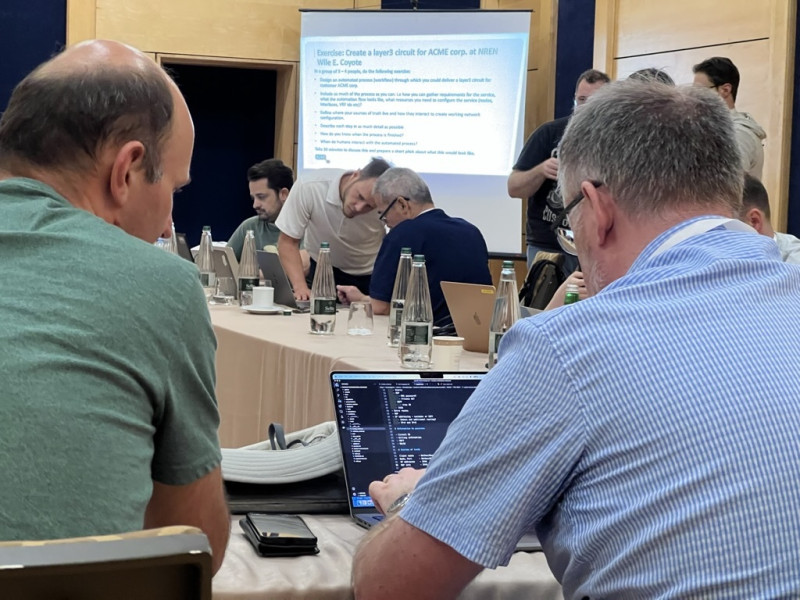
In a TNC23 workshop organized by ESnet’s Chris Cummings and SURFnet’s Hans Trompert, NREN administrators hailing from six continents took the Workflow Orchestrator for a test drive .
If the world’s scientific research networks transported people instead of data packets, in early June you would have seen a traffic spike transiting Tirana, Albania – the site of TNC23, the prestigious research and education networking conference put on by GÉANT. More than 800 participants from 70-plus countries, representing regional and national research and education networks (NRENs), schools and universities, technology providers, and world-changing scientific projects, came together in southeastern Europe for three days of discussion and collaboration.
A sizable delegation from the Department of Energy’s Energy Sciences Network (ESnet) was there, both to share with and learn from their peers. As the United States’ foremost scientific research network, ESnet partners with GÉANT, a federation of European NRENs, as well as with multiple individual NRENs such as SURF in the Netherlands. They’re united by a similar goal: to provide innovative networking infrastructure and services that support and advance scientific research all over the world.
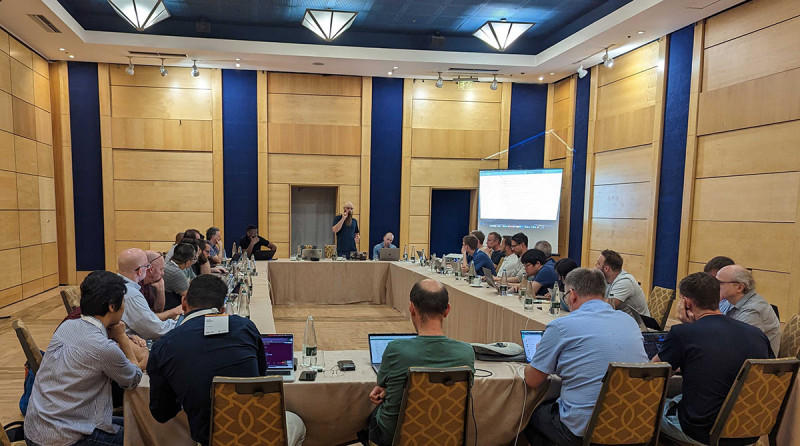
Cummings (standing) and ESnet’s Nemi McCarter-Ribakoff (seated, center) kick off the Workflow Orchestrator workshop
Hands-On Knowledge Transfer and Collaboration
In that vein, ESnet Orchestration and Core Data Software Engineer Chris Cummings, with help from ESnet colleagues Nemi McCarter-Ribakoff and Brian Eschen, teamed up with SURFnet's Hans Trompert and Peter Boers for the well-received session “From Zero to Orchestrated—A Workflow Orchestrator Workshop.” This was the first time that ESnet and SURF have together shared the in-depth learnings and hard-earned knowledge gained by their network and software engineers.
Network orchestration and intent-based networking refers to the design and centralized coordination of network resources that allows higher-level services to be realized on the network. This is in contrast to the legacy approach of individual configuration and provisioning of routers, switches, firewalls, and other network devices to deliver a network service. The open-source Workflow Orchestrator tool developed by SURF and ESnet helps network administrators both automate (execute repetitive tasks reliably and easily) and orchestrate (adding a layer of intelligence to tasks being automated and a complete audit log of changes).
Many NRENs would like to add more orchestration, but getting started can be a daunting task requiring a lot of forethought and domain knowledge. Representatives from more than 20 NRENs from six continents attended the all-day, interactive workshop at TNC, which began with introductions to product and workflow modeling, followed by interactive development sessions, and ending with an open discussion around tailoring the Workflow Orchestrator to theoretical use cases. The goal was for attendees to get a locally running version of the Workflow Orchestrator on their laptops as well as some example workflows, provide guided troubleshooting, and show how to make code changes to fix bugs.
While the attendees appreciated having a working environment to take home with them, “it was also very beneficial for us – learning how to think in an orchestration-forward manner by spending time planning out theoretical product designs with other R&E community members,” says Cummings.
There were challenges: some had trouble getting the workshop running, due to unfamiliarity with the docker containerization platform, as well as not having administrative rights to install docker on their systems. Pulling resources over the hotel wifi was also difficult, but Cummings reports that “Karl Newell from Internet2 came up with some really clever solutions to help his fellow workshop-mates access the images locally – a great example of cross-R&E teamwork!” Cummings and Trompert, McCarter-Ribakoff, and other ESnet engineers will be applying these lessons learned to the next edition of the Workflow Orchestrator workshop, planned for Internet2’s TechEx conference in late September.
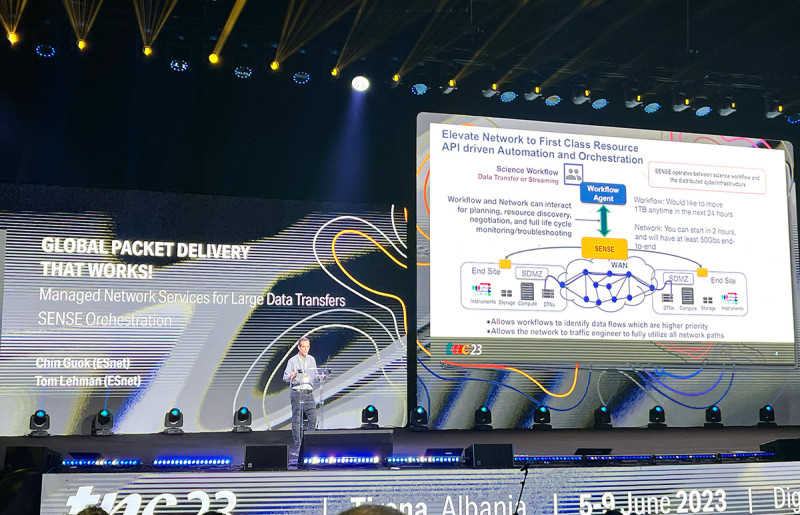
ESnet’s Tom Lehman explained the advantages of SENSE orchestration to the TNC23 audience.
ESnet at TNC23
Among ESnet’s other speakers and presenters were Chief Technology Officer and Planning & Innovation Group Lead Chin Guok and ESnet/Berkeley Lab Networked Systems Researcher and Developer Tom Lehman, who took the massive concert hall stage to share an overview of Managed Network Services for Large Data Transfers, focusing on the integration work between the SENSE [SDN for End-to-End Networking at Exascale] orchestration and Rucio data management systems. Their goal was to demystify the often opaque role of the network in science workflow processes by showing how advanced wide area network traffic engineering, end site infrastructure awareness/control, and domain science workflow intelligence can improve research results and planning abilities.
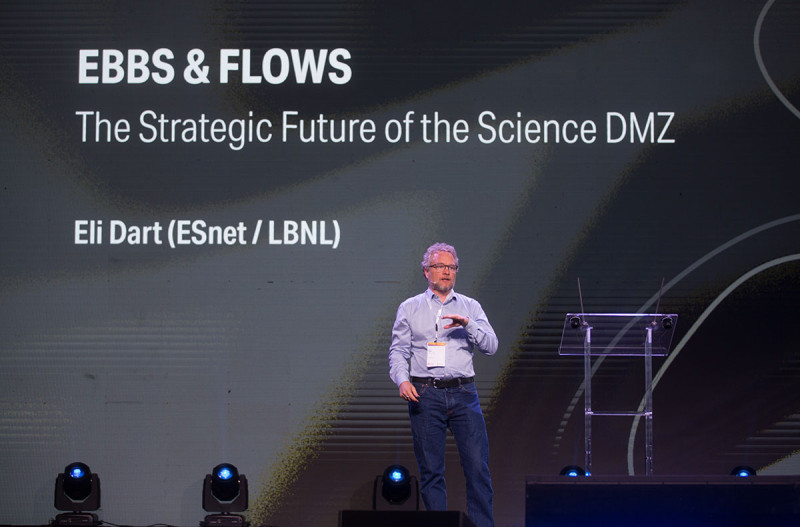
Science Engagement Acting Group Lead Eli Dart gave an update on the high-performance network design pattern Science DMZ.
ESnet Science Engagement Acting Group Lead Eli Dart presented on The Strategic Future of the Science DMZ, the science-focused high-performance network design pattern created by ESnet, highlighting new environments and applications such as Streaming DTNs, Zero Trust, and Exascale HPC, and workflows that couple experimental and computing facilities to achieve previously unachievable results. Dart also teamed up with Karl Newell from Internet2 to talk about Identifying and Understanding Scientific Network Flows, in particular the effort underway from the High-Energy Physics (HEP) and Worldwide LHC Computing Grid (WLCG) communities to mark packets/flows so they can be correlated with specific research projects. This approach, which allows identification of flows for troubleshooting and gives network providers visibility into the research flows they support, can be leveraged by any research organization and network provider willing to participate in packet marking.
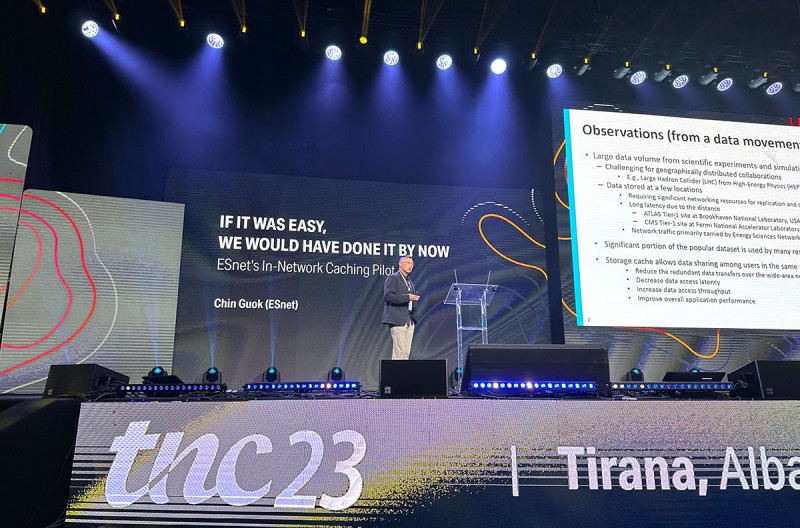
Chin Guok shared an assessment of the effectiveness of ESnet’s pilot cache system.
Planning & Architecture Computer Systems Engineer Nick Buraglio chaired a session titled “If It Was Easy, We’d Have Done it By Now” about innovations in networking that included Guok summarizing the findings of ESnet's In-Network Caching Pilot. Guok also co-chaired a workshop, Planning and Development in R&E Networks, that included strategy discussion for approaches to intercontinental connectivity, packet layer renewal, automation, and Big Science requirements.
It was an intense couple of days of networking. Another half-dozen ESnetters, including Executive Director Inder Monga, were also in Albania to attend TNC23. A group of them unwound after the conference ended by going on a challenging hike above stunning Lake Bovilla.
“We all learned a lot,” said Cummings. “And it was great to be able to contribute in a concrete way to the workflow orchestration community.”

After TNC ended, a group of ESnetters hiked up above Lake Bovilla, a reservoir northeast of Tirana within Mount Dajt National Park. Photo: Brian Eschen



